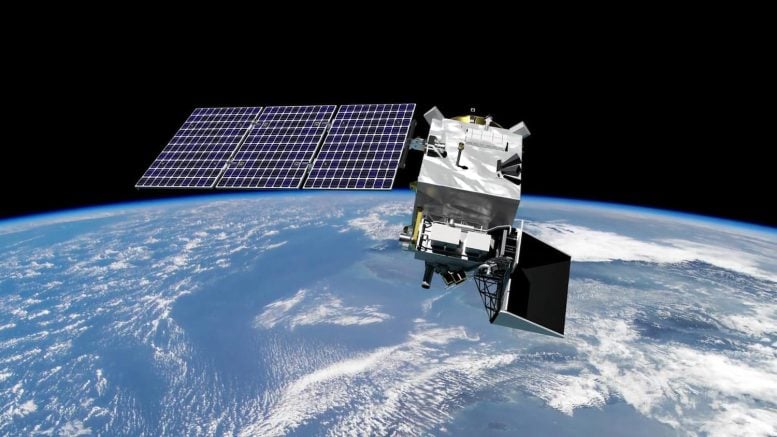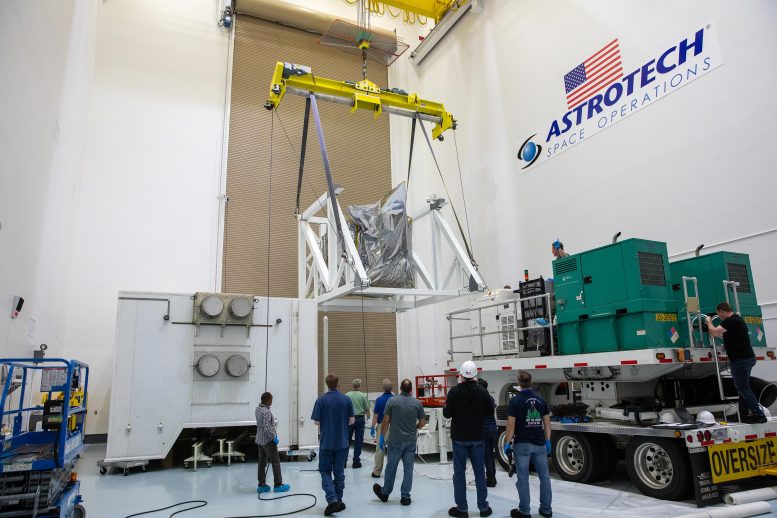
NASA’s PACE (Plankton, Aerosol, Cloud, ocean Ecosystem) spacecraft in orbit over Earth. The PACE observatory will help us better understand how the ocean and atmosphere exchange carbon dioxide, measure key atmospheric variables associated with air quality and Earth’s climate, and monitor ocean health, in part by studying phytoplankton, tiny plants, and algae that sustain the marine food web. Credit: NASA GSFC
NASA’s PACE spacecraft arrived in Florida for its 2024 launch on a SpaceX Falcon 9 rocket. Managed by the Goddard Space Flight Center, the mission will study ocean-atmosphere interactions and continue crucial climate and air quality measurements.
NASA’s PACE spacecraft completed its journey on November 14, from NASA’s Goddard Space Flight Center in Greenbelt, Maryland, to the Astrotech Spacecraft Operations facility near the agency’s Kennedy Space Center in Florida.
Engineers and technicians arrived ahead of the spacecraft to prepare ground equipment for offloading and processing before fueling and final encapsulation.

Technicians monitor movement as a crane hoists NASA’s Plankton, Aerosol, Cloud, ocean Ecosystem (PACE) observatory spacecraft after being uncrated on November 15, 2023, at the Astrotech Space Operations Facility near the agency’s Kennedy Space Center in Florida. PACE will be encapsulated for launch aboard a SpaceX Falcon 9 rocket from Space Launch Complex 40 at Cape Canaveral Space Force Station in Florida. Credit: NASA/Ben Smegelsky
PACE, which stands for Plankton, Aerosol, Cloud, and ocean Ecosystem, is targeted to launch aboard a SpaceX Falcon 9 rocket in early 2024, from Space Launch Complex 40 at Cape Canaveral Space Force Station in Florida. The mission will help clarify how the ocean and atmosphere exchange carbon dioxide, improve upon NASA’s 20-plus years of global satellite observations of ocean biology and atmospheric aerosols, and continue key measurements related to air quality and climate.
The PACE project is managed by NASA’s Goddard Space Flight Center. The agency’s Launch Services Program, based at Kennedy Space Center, is responsible for managing launch service for the PACE mission.









We humans are imprisoned on earth and we will not find any way to escape from this prison and we will not find a better life on any planet that is close to us.And there is no oxygen in any part of the galaxy as in the solar system, because the earth and the sun 25,000 light years from the center of the galaxy and that alone has the most water and oxygen, but outside the galaxy, life like Earthwould reach infinity because there is an infinity of galaxies in space, plenty of water and oxygen for life to emerge.If we go from the arm of the galaxy to the center of the galaxy, there is not as much water and oxygen as there is on Earth.This is very controversial.I will give you a simple example.If a tank ten meters high and long and have a width of two meters.Pour crude oil into that tank until it expands five meters and heat it up to 250 degrees.Light materials such as gas, gasoline and diesel are placed on top of the tank up to a height of ten meters and heavier materials such as bitumen in They are located at the bottom of the tank.This is due to the gravity of the Earth.The galaxy, water and oxygen like gas and gasoline are located at the edge of the galaxy due to their lightness, and this is due to the effect of the gravitational force of the objects and the gravity of the galaxy core.To other elements in the galaxy , but maybe this is in your mind, how can you put water and oxygen 25,000 light years away from us, water and oxygen were that far before the formation of planets and stars in the galaxy.And the core of the new galaxy is forming.It was in the form of dust, and the dust, which was heavier than oxygen, was in the center of a very, very large cloud nebula.The most important thing that has caused life on earth and the solar system is the placement of the sun in the path of the two arms of the galaxy.And the weight of the sun is due to the mass and heavy weight it has compared to the stars of the arm of the galaxy.The sun never accompanies the arm of the galaxy.The two large arms of the galaxy are a million times lighter than the Sun.As a result, they revolve around the core of the galaxy much faster than the Sun, and because the Sun is in the path of the stars of the arm, the very small stars of the arm are constantly colliding with solar objects and They are lesslikely to collide with the Sun itself, because as the arm stars move, they must pass through the orbits of four gas giant planets, such as Neptune, then Uranus, and then Saturn.reach the sun, so 95% of the stars that come to the sun collided with Neptune, Uranus, Saturn, Jupiter, and the planets that came with those stars caused Neptune, Uranus, Saturn, Jupiter to have 231 moons and join the solar systemwith them.The reason for the hydrogen gas in the planets Neptune, Uranus, Saturn and Jupiter was due to the impact of small stars, which I explained came from the arm of the galaxy and hit the solar bodies.I will continue in the next comments in the near future for you readers of this website, greetings to you Mrdr . Mehrdad from Iran, I am waiting for your messages.Do not send messages to my email, it does not work.00989332197646